Retiring in Latvia: Affordable Living and Rich Culture in the Baltics
13 min readOld Town Riga captivated us the moment we stepped onto its cobblestone streets and saw the medieval architecture. What stories were embedded in these stone walls, narrow passages, and town squares?
The aroma of baking dark rye bread filled the air, emanating from a bakery as we walked along the narrow streets flanked by shops, pubs, and sidewalk cafes. In the early morning, the streets were quiet, with only the occasional delivery and a handful of coffee lovers enjoying their morning brew at sidewalk cafes. We joined the early birds, leisurely sipping our tea and munching freshly baked chocolate croissants. We absorbed the ambiance as the day slowly unfolded before us. The walls were about to tell their stories in Old Town Riga, a UNESCO World Heritage Site.
Sign up for our free daily IL Postcards e-letter and we’ll immediately send you a free report on the WORLD’S #1 RETIREMENT HAVEN—plus 9 more of the most desirable and very affordable destinations where you can upgrade your retirement right now. Each day you’ll learn about the best places to retire, travel, buy real estate and enjoy life overseas.
By submitting your email address, you will receive a free subscription to IL Postcards and special offers from International Living and our affiliates. You can unsubscribe at any time, and we encourage you to read more about our Privacy Policy.
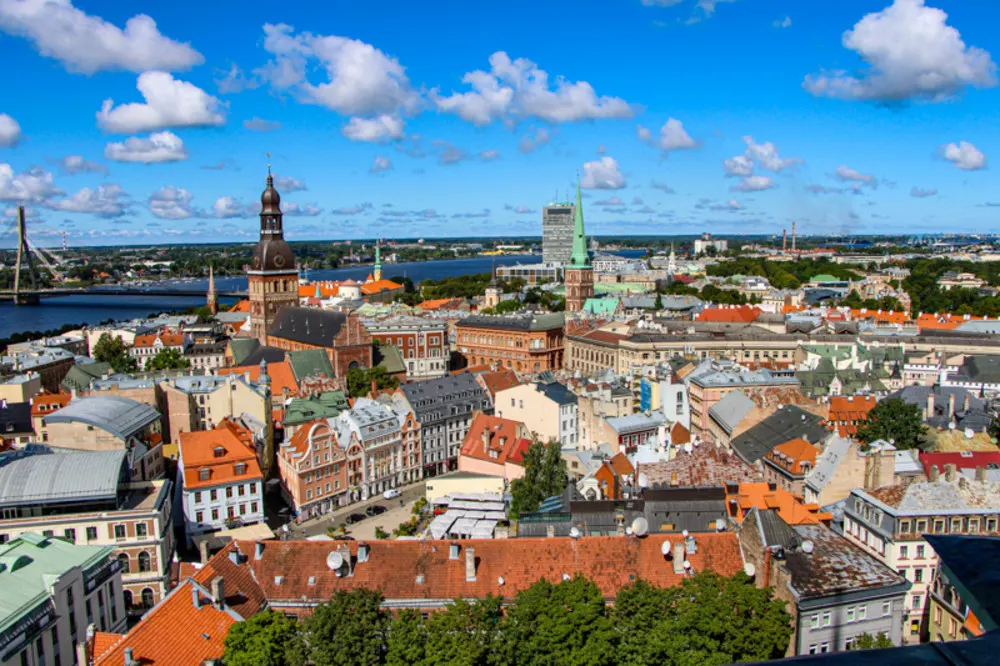
Old Town Riga’s iconic red-tile roofs offer a glimpse into Latvia’s rich past.|©Kevin Scanlon
We were on a scouting mission to discover what retirement would be like in one of the Baltic States (Latvia, Estonia, Lithuania). We planned to spend ten days there, living like locals, and researching life in Riga, Kuldīga, and Sigulda.
Here’s what we learned —
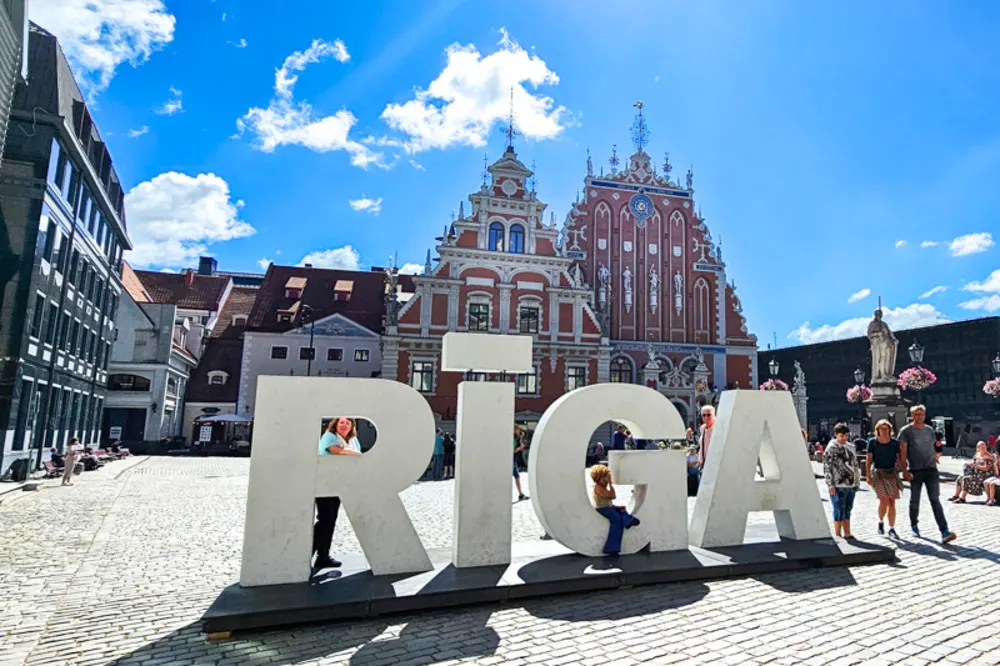
A warm welcome awaits in Riga’s iconic Town Hall Square.|©Kevin Scanlon
Latvia’s capital, Riga, is known for its medieval architecture, cobblestone streets, and vibrant cultural scene. The city’s Old Town, a UNESCO World Heritage Site, is a treasure trove of historic buildings, churches, and museums.
Riga is also a hub for arts and entertainment, with numerous theaters, galleries, and music venues. Its bustling markets, sidewalk cafes, and lively nightlife make it a popular destination. With a rich history and a blend of old-world charm and modern amenities, Riga offers a unique and unforgettable experience.
One-third of Latvians live in Riga, Latvia’s largest city, with a population of 619,000. There is a large expat population with members from around the globe, including North America and the UK.
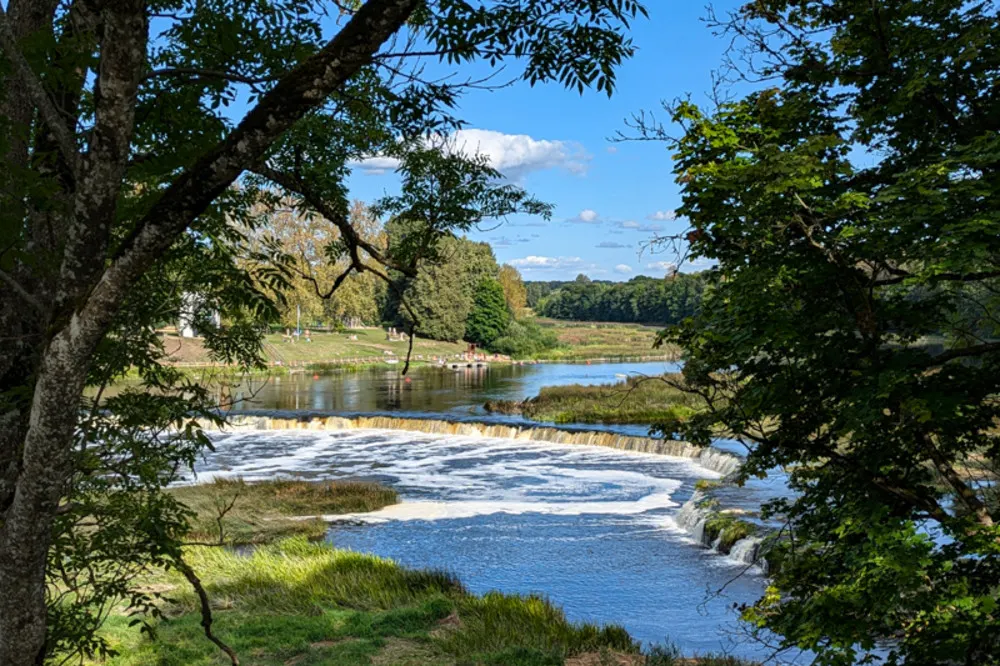
Venta Rumba in Kuldīga—Europe’s widest waterfall, spanning 819 feet.|©Mary Charlebois
Kuldīga, a lovely town in western Latvia, is known for its picturesque surroundings and historic architecture. This small town is famous for its brick bridge, one of the longest in Europe. The Venta Rumba, a wide waterfall on the Venta River, is a prominent natural attraction in Kuldīga.
The town’s well-preserved medieval buildings and cobblestone streets create a tranquil and nostalgic atmosphere, making it an ideal destination for history enthusiasts and nature lovers. With its peaceful ambiance and beautiful landscapes, Kuldīga offers a serene retreat from the hustle and bustle of city life. The population is 9,940, which includes expats and retirees.
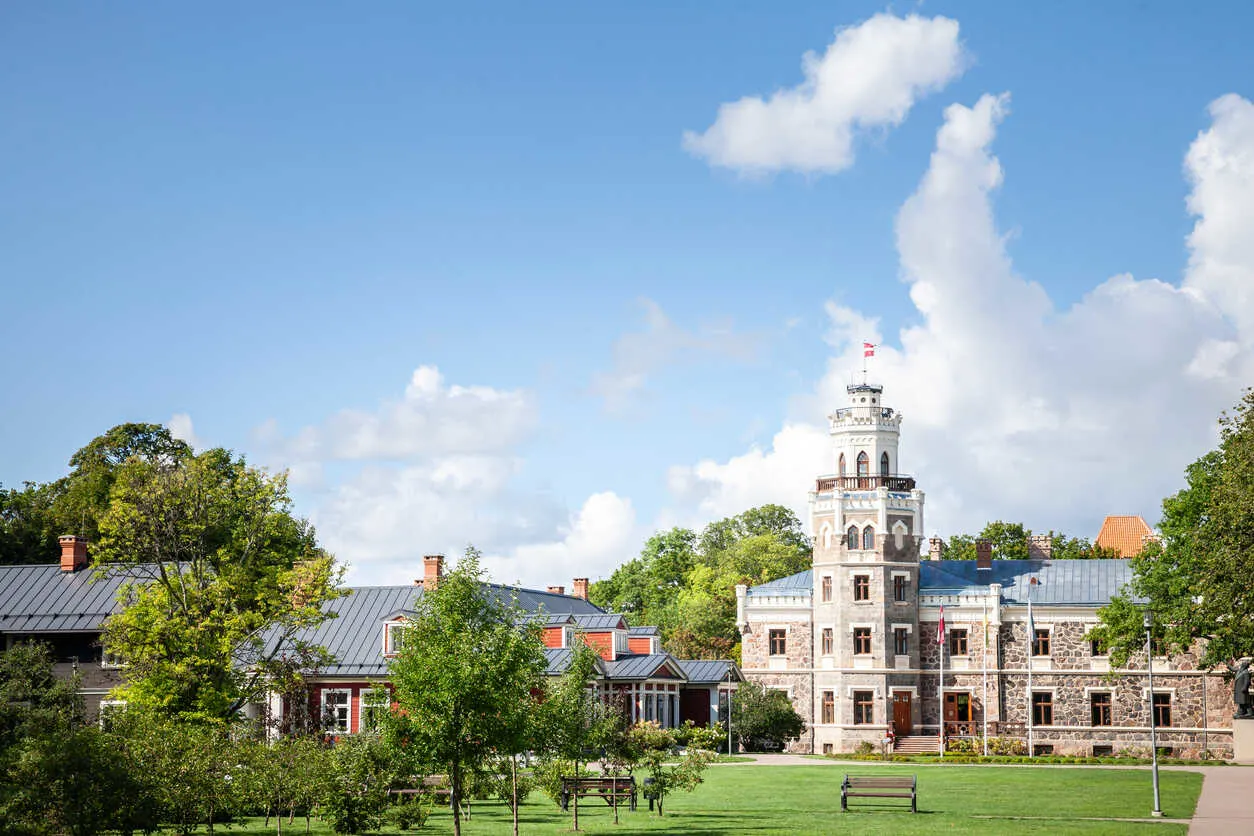
The New Sigulda Castle, built in 1878, now home to a fascinating museum.|©iStock/BalkansCat
Sigulda, located in the Gauja River Valley, is a picturesque town in Latvia known for its spectacular natural landscapes and rich history. Often referred to as the “Switzerland of Latvia,” Sigulda is a paradise for outdoor enthusiasts, offering magnificent views of the Gauja River, dense forests, and ancient castles.
The town is famous for its medieval Turaida Castle, which stands amidst lush greenery, inviting you to step back in time and explore its history.
Adrenaline seekers can enjoy outdoor activities such as hiking, cycling, and bobsledding, making Sigulda a perfect destination for adventure lovers. With its tranquil atmosphere, historical landmarks, and abundant natural beauty, Sigulda is a hidden gem that captivates the hearts of all who visit. The population is 14,632, including expats and retirees.
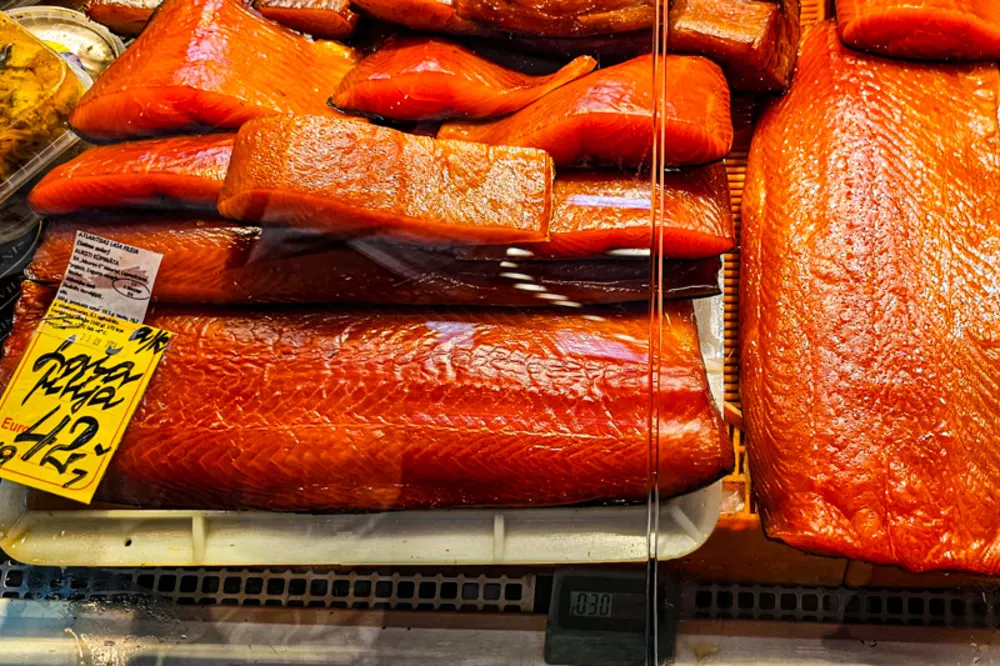
Smoked salmon on display at Riga’s Central Market, the largest in Eastern Europe.|©Kevin Scanlon
Latvia’s currency is the Euro. Most businesses will accept credit or debit cards. Before using a card there or anywhere outside your home country, let your bank and credit card companies know you will be traveling.
| Average Living Expenses* | US$ |
|---|---|
| Monthly rent for a 900 sq ft furnished apartment in an expensive area. | 1,043 |
| Monthly rent for a 900 sq ft furnished apartment in an average area. | 611 |
| Monthly utilities – water, electricity, and gas for two people in a 900 sq ft apartment. | 239 |
| Monthly high-speed Internet. | 19 |
| Monthly mobile phone – 4G network. | 19 |
| Monthly public transit ticket. | 36 |
| One liter gasoline (1/4 gallon). | 2 |
| Monthly groceries for two, 2400 calories per person per day. | 519 |
| Entertainment for two — | |
| Dining out – a 3-course dinner in a mid-range restaurant | 67 |
| Theater – best seats | 88 |
| Movie | 19 |
| Cocktail | 18 |
| Beer | 9 |
| Cappuccino | 7 |
*(All numbers are the average costs in Latvia, converted from Euro to USD at the exchange rate on 09/2/24 and rounded to the nearest dollar.)
Shopping in Latvia was initially challenging for us due to the unfamiliar products and the fact that many items were labeled in the Latvian language. However, we were able to adapt quickly and navigate the stores more comfortably with the help of Google Translator. It was a valuable tool that allowed us to understand product labels and communicate with store staff, making our shopping experience more manageable.
In Latvian neighborhoods, shops often focus on specific products such as meat, cheese, bakery items, and groceries. Similarly, many retailers specialize in one particular type of product when it comes to clothing, shoes, household goods, and hardware. However, we saw numerous big box stores, like Home Depot. Also, malls are popping up in the suburbs. Imported goods are more expensive than those locally produced in the Baltics or EU.
Latvian is the official language of Latvia and belongs to the Baltic branch of the Indo-European language family. It is one of the two living Baltic languages, the other being Lithuanian. Latvian is known for its unique phonetic features and a rich tradition of oral literature.
Despite Latvia’s history as part of the former Soviet Union, the Latvian language remains a distinctive and essential part of its cultural identity. While many Latvians speak Russian, particularly among the older generation, younger Latvians are fluent in English, making communication relatively easy for expats.
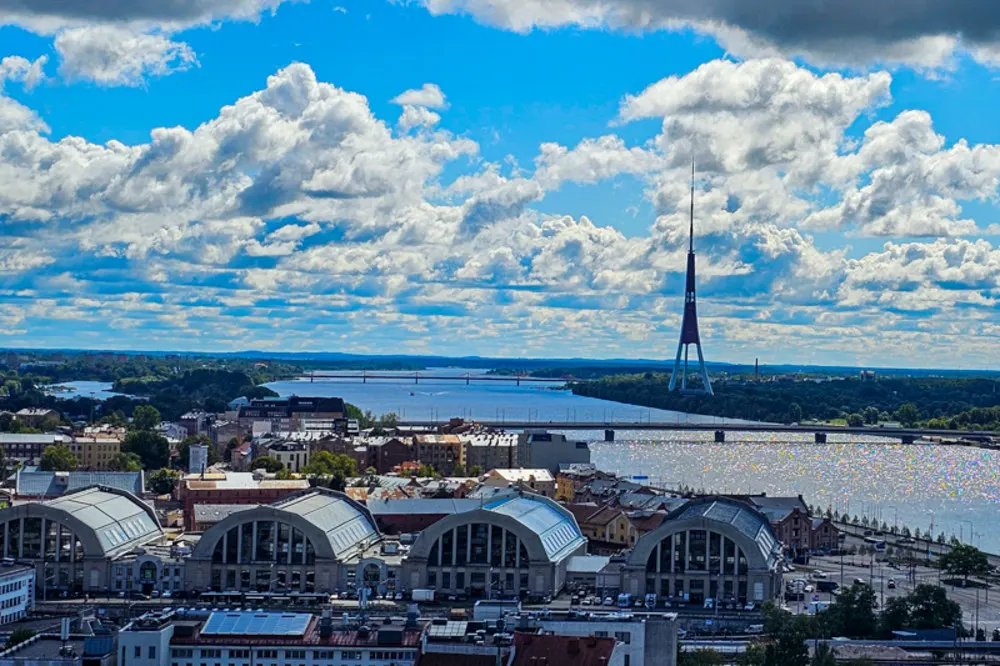
Riga’s skyline, with its iconic market housed in former Zeppelin hangars.|©Kevin Scanlon
Air — Air travel to Latvia offers convenient options, with Riga International Airport (RIX) being the main gateway. The airport is well-connected to major European cities and offers direct flights to several destinations worldwide. You can expect a comfortable experience when flying to Latvia, which has modern facilities and efficient services.
Trains—Train travel in Latvia offers a convenient and picturesque way to explore the country. The rail network connects major cities like Riga, Kuldīga, and Sigulda, providing comfortable and affordable transportation. Trains with connections to other European countries are available and inexpensive. As seniors, we were often given a 50% discount on train travel. While traveling between destinations, you will enjoy scenic views of Latvia’s countryside, making train travel a memorable experience.
Bus — Bus travel in and around Latvia is a convenient and affordable way to explore the country. The extensive bus network connects major cities and towns, offering comfortable and reliable transportation. Whether you’re heading to Riga or the countryside, buses provide a great way to soak in Latvia’s diverse landscapes.
Taxis—Taxis in Latvia are a convenient mode of transportation, especially in cities like Riga. They are readily available and can be hailed on the street or booked through mobile apps. They are generally safe and reliable, with metered fares and professional drivers. It’s a convenient option for getting around that we found to be very inexpensive at an average of $1.79 per mile.
Auto — The cost of owning a car in Latvia includes gasoline, insurance, maintenance, and parking fees. Additionally, there may be costs associated with purchasing a vehicle, such as registration fees and taxes. Latvia has been ranked as an expensive place to own and operate a car because of the high cost of autos compared to the average income.
Ferries — Ferry travel in Latvia offers cruises across the Baltic Sea, connecting the country to neighboring destinations like Sweden and Germany. Ferries have comfortable amenities. Autos, cyclists, and foot passengers are welcome aboard ferries.
Cycling and Walking — Latvia is very pedestrian —and bicycle-friendly, with most towns and villages having pedestrian-only areas and bike paths.
Sign up for our free daily IL Postcards e-letter and we’ll immediately send you a free report on the WORLD’S #1 RETIREMENT HAVEN—plus 9 more of the most desirable and very affordable destinations where you can upgrade your retirement right now. Each day you’ll learn about the best places to retire, travel, buy real estate and enjoy life overseas.
By submitting your email address, you will receive a free subscription to IL Postcards and special offers from International Living and our affiliates. You can unsubscribe at any time, and we encourage you to read more about our Privacy Policy.
Latvia is located in the Baltic region of Northern Europe. It borders Estonia to the north, Lithuania to the south, Russia to the east, and Belarus to the southeast. The country has a coastline along the Baltic Sea to the west. Latvia’s strategic location has historically made it a significant crossroad between Western Europe and the East, contributing to its diverse cultural and historical influences.
Situated on the eastern edge of the European Union, Latvia acts as a bridge between the EU and the eastern countries. This makes it a crucial trade and commerce center, especially since it became an EU member in 2004.
Latvia’s history is deeply rooted in its geographical location, a crossroads between Eastern and Western Europe. Throughout the centuries, Latvia has been influenced by various cultures and civilizations. From the medieval period to the Livonian Confederation, the Swedish and Russian Empires, and the Soviet Union, Latvia has experienced a tumultuous history of conquests and occupations.
Latvia gained independence in 1918 but was occupied again during World War II and incorporated into the Soviet Union. It finally regained its independence in 1991 and has since focused on rebuilding its identity and strengthening its position in the international community.
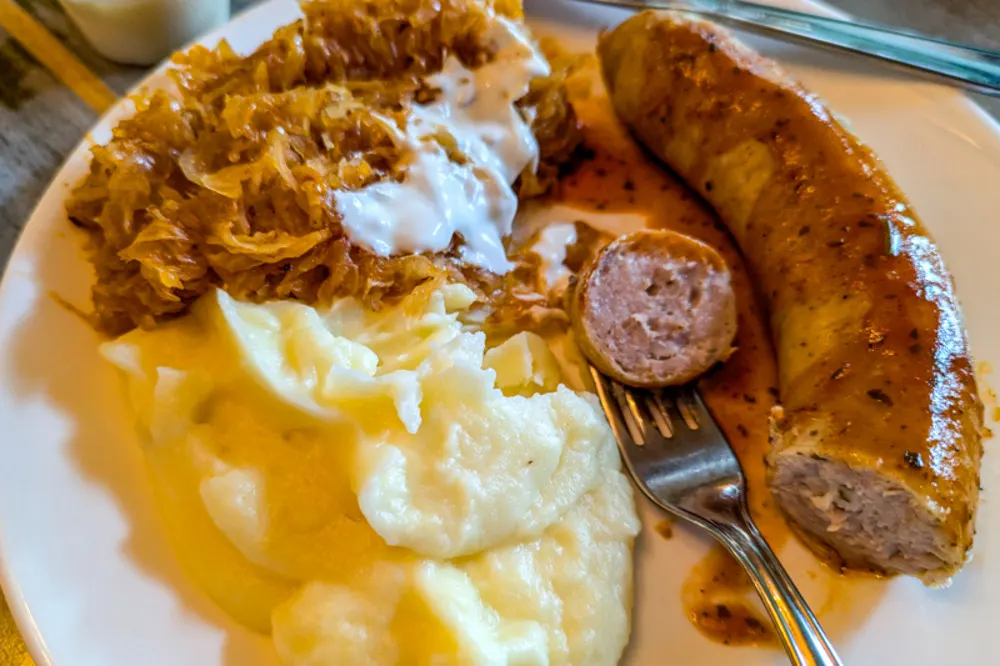
A classic Latvian meal of Rivel sausage with sauerkraut and mashed potatoes.|©Mary Charlebois
Latvian cuisine is hearty and comforting. It uses locally sourced ingredients such as potatoes, carrots, onions, cabbage, pork, freshwater fish, seafood, and dairy products.
Traditional Latvian dishes include speķapīrāgi (bacon-filled croissants), kartupeļu pankūkas (potato pancakes) served in many different ways, and incredible dark rye bread, which is used in many dishes, including desserts and soft drinks. Hearty soups and stews made with beef and root vegetables are on every menu. Latvians are master sausage makers. Be sure to try some with sauerkraut and potatoes; it will be unforgettable. Latvian food also features a wide variety of berry-based desserts and beverages.
Latvia has a growing wine and craft beer scene, offering a variety of local and international options. You can enjoy exploring wineries in the countryside and trying unique Latvian craft beers in eateries, bars, and pubs.
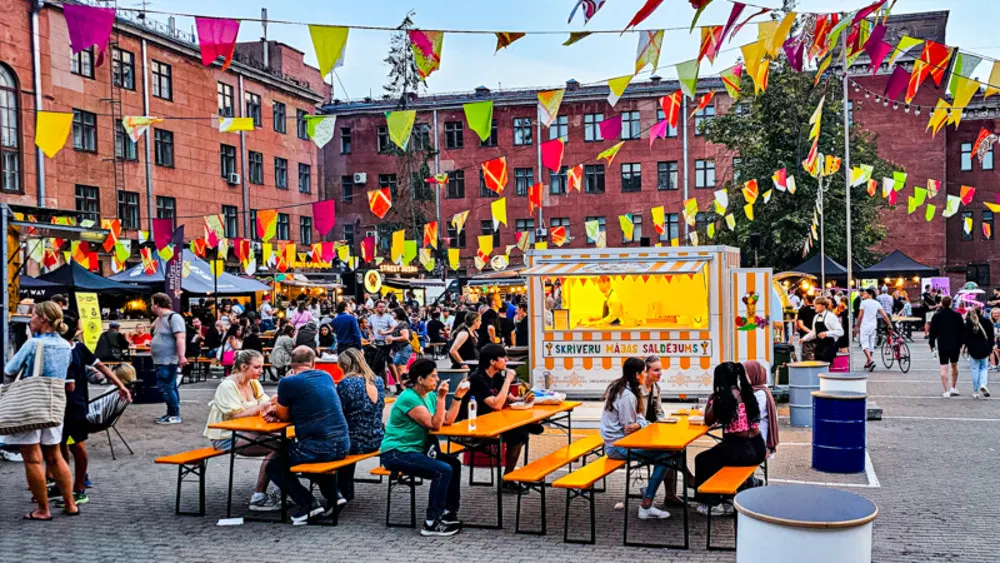
Summer brings vibrant street food festivals, perfect for enjoying Latvia’s mild weather.|©Kevin Scanlon
Entertainment and Things to Do
Latvia offers diverse entertainment and activities for residents and visitors alike. From exploring the historic Old Town Riga, a UNESCO World Heritage Site, to enjoying the vibrant cultural scene with theaters, concerts, and art exhibitions, there’s something for everyone.
Latvia is not mountainous, but 53.8% is covered in old-growth forests. This natural beauty provides opportunities for outdoor activities such as hiking, camping, and bird watching in the Gauja National Park. You can swim in the Baltic Sea, relax on the pristine beaches of Jurmala, or explore the picturesque countryside where wineries and cideries are lovely places to visit and sip the country’s libations. Latvia hosts festivals and events celebrating music, the arts, food, drink, and local traditions. Whether you are interested in history, the arts, or outdoor adventures, Latvia offers plenty.
Latvia’s healthcare is primarily funded through a national health insurance system, which provides universal coverage for all residents. The country has a network of public healthcare facilities, including hospitals, clinics, and specialized treatment centers.
Latvian residents and registered long-term residents are entitled to receive necessary medical services free of charge or at a reduced cost. However, the quality of healthcare services can vary, with some urban areas offering more advanced medical facilities than rural regions. Private healthcare services are also available, offering faster access and a more comprehensive range of treatment options for those who can afford them.

Aerial view of Kuldīga’s Old Town, showcasing its charming streets and historic architecture.|©iStock/Bargais
Latvia offers visas and residency permits for those looking to retire or live there. The most common types of visas include short-stay visas, suitable for stays of up to 90 days within 180 days, and long-stay visas, ideal for more extended visits.
For retirees interested in residing in Latvia, there are various residency permits to consider, such as temporary and permanent residence permits. Temporary residence permits are typically issued for a specific period and can be renewed, while permanent residence permits allow individuals to live in Latvia indefinitely.
Each type of visa and residency permit has specific requirements and application procedures, so it’s essential to carefully review the options and seek the necessary guidance to ensure a smooth and successful application process. Visit The Office of Citizenship and Migration Affairs for more information.
Digital Nomad visas are available in Latvia. If you are self-employed and can work remotely or if you can work remotely under contract, a digital nomad visa might be a good choice. The requirements are relatively simple.
Latvia also has one of the best digital networks in the EU. High-speed internet and communal workspaces are available for digital nomads to pursue their occupation.
Latvia offers a Retirement Visa for those 65 or older with a stable pension, such as Social Security. It is desirable and has a relatively low income requirement.
Latvia has a flat personal income tax rate of 20%, which applies to both residents and non-residents. Corporate income tax is also a flat rate of 20%. Additionally, Latvia offers various tax incentives and exemptions to attract foreign investment and encourage economic growth.
Latvia experiences a temperate seasonal climate. Winters are cold, with snowfall, while summers are mild and pleasant. The annual average temperature ranges from 42 F to 62 F. Spring and autumn bring moderate temperatures and colorful foliage.
In Latvia, the sunshine varies significantly between summer and winter. During the summer, Latvia experiences long daylight hours, with the sun setting late in the evening, providing ample sunshine for outdoor activities. In contrast, the winter months are characterized by shorter daylight hours and less sunshine, contributing to a colder and darker atmosphere.
While not everyone likes the dark winter months, they are perfect for writers, artists, and work-from-home digital nomads. Suppose Latvia interests you, but the winter isn’t your style. In that case, you can join the many expats and retirees who leave in the winter for warmer climates like the Mediterranean and then return in late spring for the mild spring/summer/fall season.
In Latvia, the family takes precedence above all. During the sunny summer, parks and squares bustle with multi-generational families in activities like walking, cycling trips, picnics, and relishing meals at sidewalk cafes.
When winter arrives, families and friends unite in the comfort of their homes and engage in various indoor activities and events. Handcrafts, including knitting, needlework, traditional craft, painting, and woodworking, thrive during the dark, cold winter months, offering a cozy and creative avenue for folks to enjoy time together.
Latvians might be called reserved, but they are never unfriendly or rude to visitors or newcomers. It is not typical for locals to speak to strangers while passing on the street, but they will respond if you break the ice. Latvians are happy to help when asked. It takes a little time, but locals will warm up, especially when you share something about yourself or your country of origin.
While there, we encountered many curious people about America and Americans. It was common to be asked if we were Americans while paying for goods at a shop or having tea in a coffee shop. Of course, when we told them we were expats living in Malta, the conversation really began. We found most Latvians could not understand why anyone would leave America. We explained the high cost of living, combined with our desire to live abroad and immerse in other cultures. It was amazing how many Latvians also wanted to live in another country, even briefly.

Colorful buildings and vibrant cafes bring charm to Riga’s historic Old Town.|©iStock/nantonov
Retiring in Latvia offers a rich history, charming cities, and affordable living. UNESCO World Heritage Cities and Old Towns create a picturesque backdrop for retirees, digital nomads, and retirement entrepreneurs.
You can comfortably settle in Latvia with a moderate cost of living, including affordable housing and utilities. Latvia’s distinct culture and language add to the appeal of retiring in this Baltic State, providing a peaceful and culturally enriching environment to call home.
When we asked ourselves what would make Latvia our next digital nomad home, we had many answers, such as its rich history, medieval architecture, and vibrant cultural scene. We also like the natural beauty of places like Kuldīga and Sigulda, with their picturesque surroundings and tranquil atmosphere. The beach town of Jurmala was a melting pot of Europeans on holiday and spa retreats. There, we met folks from Germany and Spain in a sidewalk cafe. Jurmala is where we learned that line dancing to American Country music is very popular all over the country.
Most importantly, the cost of living is reasonable. In Latvia, we could live comfortably on our Social Security alone.
Lastly, the government offers several appealing visa/residency schemes.
Our scouting expedition gave Latvia a double thumbs-up as a place to retire or begin a new life in a new culture. Traveling in Latvia is easy on your budget. Take a trip there and do your own scouting mission.
Laimīgus ceļojumus! (Happy travels)
Sign up for our free daily IL Postcards e-letter and we’ll immediately send you a free report on the WORLD’S #1 RETIREMENT HAVEN—plus 9 more of the most desirable and very affordable destinations where you can upgrade your retirement right now. Each day you’ll learn about the best places to retire, travel, buy real estate and enjoy life overseas.
By submitting your email address, you will receive a free subscription to IL Postcards and special offers from International Living and our affiliates. You can unsubscribe at any time, and we encourage you to read more about our Privacy Policy.



